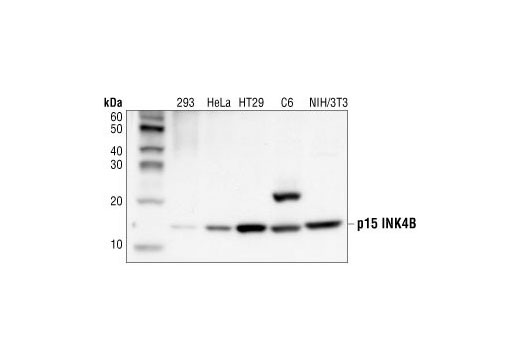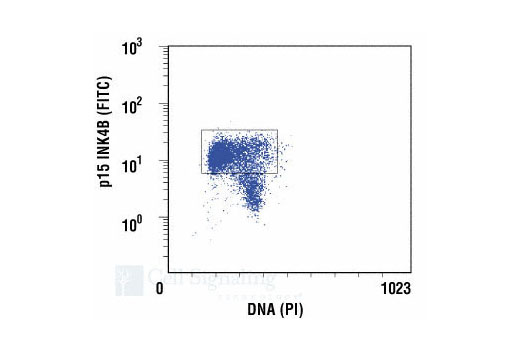WB, FC-FP
H M R
Endogenous
15
Rabbit
#P42772
1030
Product Information
Product Usage Information
| Application | Dilution |
|---|---|
| Western Blotting | 1:1000 |
| Flow Cytometry (Fixed/Permeabilized) | 1:25 |
Storage
Specificity / Sensitivity
Species Reactivity:
Human, Mouse, Rat
Source / Purification
Polyclonal antibodies are produced by immunizing animals with a synthetic peptide corresponding to the amino terminus of human p15 INK4B. Antibodies are purified by protein A and peptide affinity chromatography.
Background
Cyclin-dependent kinases (CDKs) are activated in part by forming complexes with cyclins. For example, CDK4 and CDK6 associate with the D-type cyclins and phosphorylate the retinoblastoma protein. This phosphorylation is a necessary event for cells to enter S-phase (1). The inhibitors of CDK4 (INK4) family include p15 INK4B, p16 INK4A, p18 INK4C and p19 INK4D. p18 has been shown to function as a haploinsufficient tumor suppressor in vivo (2). All INK4 proteins are composed of 32 amino acid ankyrin motifs and selectively inhibit CDK4/6 activity. Mutational analyses of p18 implicate the third and the amino-terminal portion of the fourth ankyrin repeat in mediating binding to CDK4/6 (3). The interaction of INK4 family members can be a binary complex with CDK4/6 or ternary complex with cyclin D-bound CDK4/6 and ultimately results in the inhibition of cell cycle progression (4,5).
The gene encoding p15 INK4B is often silenced by hypermethylation in acute myeloid leukemia and deleted in acute lymphocytic leukemia (6).
- Lukas, J. et al. (1996) Mol. Cell. Biol. 16, 6917-6925.
- Bai, F. et al. (2003) Mol. Cell. Biol. 23, 1269-1277.
- Noh, S.J. et al. (1999) Cancer Res. 59, 558-564.
- Guan, K.L. et al. (1994) Genes Dev. 8, 2939-2952.
- Hirai, H. et al. (1995) Mol. Cell. Biol. 15, 2672-2681.
- Drexler, H.G. (1998) Leukemia 12, 845-859.
Species Reactivity
Species reactivity is determined by testing in at least one approved application (e.g., western blot).
Western Blot Buffer
IMPORTANT: For western blots, incubate membrane with diluted primary antibody in 5% w/v BSA, 1X TBS, 0.1% Tween® 20 at 4°C with gentle shaking, overnight.
Applications Key
WB: Western Blotting FC-FP: Flow Cytometry (Fixed/Permeabilized)
Cross-Reactivity Key
H: human M: mouse R: rat Hm: hamster Mk: monkey Vir: virus Mi: mink C: chicken Dm: D. melanogaster X: Xenopus Z: zebrafish B: bovine Dg: dog Pg: pig Sc: S. cerevisiae Ce: C. elegans Hr: horse GP: Guinea Pig Rab: rabbit All: all species expected
Trademarks and Patents
Limited Uses
Except as otherwise expressly agreed in a writing signed by a legally authorized representative of CST, the following terms apply to Products provided by CST, its affiliates or its distributors. Any Customer's terms and conditions that are in addition to, or different from, those contained herein, unless separately accepted in writing by a legally authorized representative of CST, are rejected and are of no force or effect.
Products are labeled with For Research Use Only or a similar labeling statement and have not been approved, cleared, or licensed by the FDA or other regulatory foreign or domestic entity, for any purpose. Customer shall not use any Product for any diagnostic or therapeutic purpose, or otherwise in any manner that conflicts with its labeling statement. Products sold or licensed by CST are provided for Customer as the end-user and solely for research and development uses. Any use of Product for diagnostic, prophylactic or therapeutic purposes, or any purchase of Product for resale (alone or as a component) or other commercial purpose, requires a separate license from CST. Customer shall (a) not sell, license, loan, donate or otherwise transfer or make available any Product to any third party, whether alone or in combination with other materials, or use the Products to manufacture any commercial products, (b) not copy, modify, reverse engineer, decompile, disassemble or otherwise attempt to discover the underlying structure or technology of the Products, or use the Products for the purpose of developing any products or services that would compete with CST products or services, (c) not alter or remove from the Products any trademarks, trade names, logos, patent or copyright notices or markings, (d) use the Products solely in accordance with CST Product Terms of Sale and any applicable documentation, and (e) comply with any license, terms of service or similar agreement with respect to any third party products or services used by Customer in connection with the Products.

